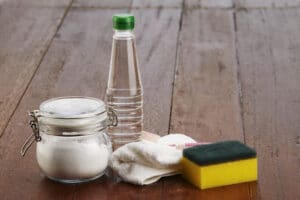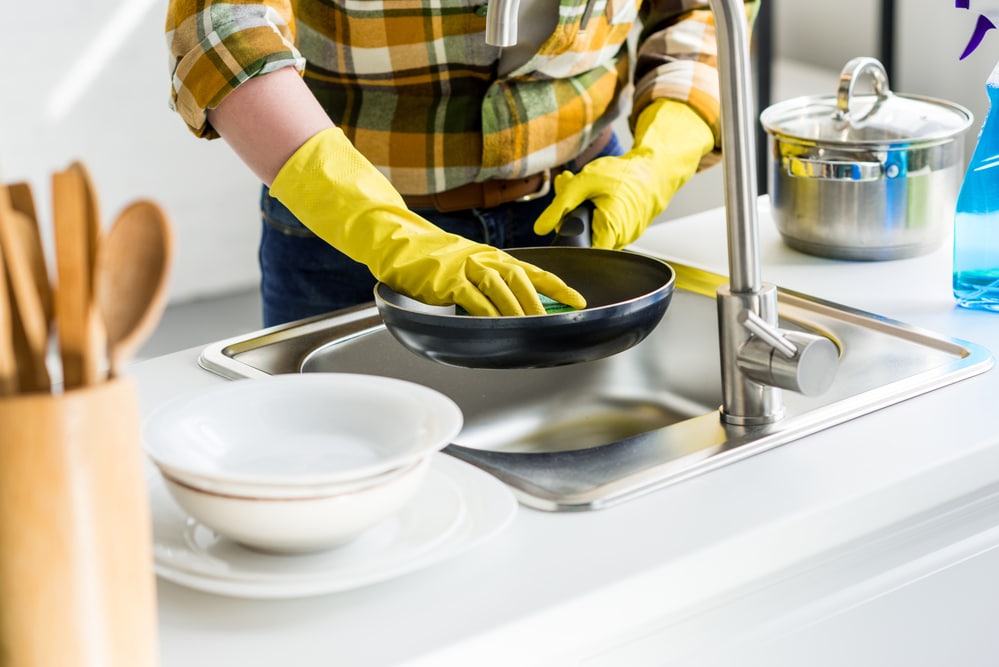Last Updated on January 10, 2023
We all try to avoid burning our food and the bottom of the pan when we cook but, mistakes happen. Don’t worry though, should the event arises, all is not lost. Fortunately, there are several ways you can remedy a burnt pan using common products found in your home kitchen and just a bit of elbow grease. This article teaches you how to clean burnt saucepans using five easy methods and explores some cleaning tips that aim to assist you along the way. With our help, you’ll have pans that are burn-free, shiny, and ready for use again in no time at all.
Gather Your Supplies
 Before you start the cleaning process, you should first gather all of the supplies you will need to get the job done.
Before you start the cleaning process, you should first gather all of the supplies you will need to get the job done.
Depending on the solution you have in mind, the supplies will vary. Not all of the stuff listed below will be necessary to execute each method. However, visualising the possible ingredients needed will help you get prepared and may also make it easier for you to decide which method to try. We recommend testing whichever technique you already have the supplies for in your home.
Basic Materials:
- Scouring pad, scrub brush, or aluminium foil ball
- Wooden spatula
- Hot water
Possible Cleaning Products Needed Depending on the Method:
- Dish soap/washing up liquid
- Lemons, sharp knife, cutting board
- Coarse salt
- Baking soda
- White vinegar
- Fabric softener dryer sheet
- Dishwasher tablet or biological washing powder
View this post on Instagram
Easy Cleaning Methods
Without further ado, here is how to remove burnt food from pan bottoms using 5 easy methods.
1. Boiling Lemons
The high acidity found in lemon juice makes it a great cleaner when it comes to cleaning a burnt saucepan.
Simply quarter a few lemons, 1-3 should be plenty depending on the size of your pan, and then toss them into your burnt pan. Add 5 to 10 centimetres of water and bring the contents of your pan to a boil. Allow the water to boil for 5 to 10 minutes. As the hot water boils, you should start to see chunks of the burnt-on food bits float to the surface.
Next, dump the lemon water mixture and rinse your pan. Almost all of the burnt bits should be gone at this point but if any remain, they should be fairly loose by now and will most likely come off if you scrub them with a scouring pad.
2. Baking Soda and White Vinegar
 Baking soda and vinegar is a common household DIY cleaning solution that can be highly effective on all types of messes, burnt pans included.
Baking soda and vinegar is a common household DIY cleaning solution that can be highly effective on all types of messes, burnt pans included.
Add equal parts warm water and white vinegar to the bottom of your burnt pan making sure to completely cover all of the burnt bits. Bring the solution to a boil for one minute.
Dump the solution and cover the bottom of your stainless steel pan with baking soda. This should make a paste-like substance that is abrasive enough to help you scrub the pan and lift the burnt food. Using your preferred scrubbing tool, scrub until all of the burnt bits have been removed.
Rinse and repeat the final baking soda step using a small amount of water to create the paste-like cleaning ingredient.
3. Dryer Fabric Softener Sheet
While it may be hard to imagine this method working very well, you may be surprised to see it in action. However, the high absorbency of the dryer sheet actually works wonders when it comes to pulling up stuck-on messes.
Start by filling your pot or pan with water making sure to cover the bottom completely. Then lay a dryer sheet across the pan and press it under the warm water until it is entirely submerged and resting on the bottom of your pan. Let it soak for an hour or more.
After the pan soaks, toss out the water and the dryer sheet. Ideally, most of the mess on your burnt pans will stick to the dryer sheet or at least start to be loosened by the chemicals it contains. Finish this step by scrubbing any remaining burnt bits off the bottom of your pan with dish soap and an abrasive scrubbing pad.
4. Dishwasher Tablet and/or Biological Washing Powder
Dishwasher tablets and biological washing powder enzymes can also be used in heavier concentrations than normal to clean a burnt pan.
Start by filling your pots or pans with a few centimetres of water. You can start with hot water or heat it up on your hob to begin the cleaning process. Once the water is hot, you can use a hard dishwasher tablet to scrape the burnt chunks off of the base of your pans.
You can also try adding biological washing powder to the hot water and letting it soak. Let the solution soak for 15 minutes or more, overnight may give you the best results if your time frame allows. When you return to it the next day, the burnt mess should rinse out of your pans – no scrubbing required.
5. Salt and Dish Soap
Salt can also make an excellent cleaning agent for your burnt cookware, especially if they have scorch marks or the mess is particularly greasy. We recommend using Kosher salt as it has a coarser texture and can help minimise the amount of scrubbing needed.
To begin, fill your pan with warm water and add a fair amount of salt and a squirt of washing-up liquid. Use a scouring pad to scrub the burnt parts of your pan, making sure to rub the salt directly into the mess.
This method may require a bit more physical work but it can be a good way to clean a burnt pan when you don’t have time to let it soak.
Other Considerations and Pro Tips
Here are just a few more tips and hacks to help make your cleaning process run smoothly.
- The best way to clean a burnt pan ultimately depends on the type of food stuck on the bottom of your cookware. Therefore, different techniques are better for different kinds of messes. If the first method you try doesn’t give you the results, you may want to try another.
- Cream of tartar can be a substitute for baking soda as a cleaning agent.
- An aluminum foil ball can be used in the same way as a scrub pad to clean your burnt pans. Some people even prefer using a foil ball because it can be tossed out when the process is complete.
- A wooden spatula could also help you remove larger chunks of burnt-on mess. While it won’t scrub your pans, the leverage it provides will help you get stubborn pieces loose.
Conclusion
Cleaning a burnt pan probably isn’t your idea of a good time but if you use one of the above methods, at least it can be quicker and easier than you may have anticipated. Just remember, now that you know how to clean burnt saucepans there is no need to keep putting the task off and you certainly won’t have to toss an accidentally burnt pan in the bin ever again. Whether you just wanted to be prepared, or you already have a burnt-on mess to address, you now have all of the information needed to clean burnt pans. Which technique will you try first?
Let us know what works best for you!
Emily is a woman of many talents. She has a B.A. in English and enjoys writing. Emily loves accessorising her home with quality products that not only serve a purpose but also enhance the overall convenience and tranquillity of her living space; there’s nothing like coming home to your own personal sanctuary after a long day! She loves anything that can make life easier or more comfortable—from dishware to furniture to lighting fixtures.

